Are People Ready to Entrust Their Safety to an Autonomous Ambulance as an Alternative and More Sustainable Transportation Mode?
Abstract
1. Introduction
2. Related Work
3. Methodology
3.1. Participants
3.2. Materials and Procedure
4. Results and Discussion
4.1. ‘t-Test’: Paired Two Samples for Mean Values (Hungary)
4.2. ‘t-Test’: Paired Two Samples for Mean Values (Kazakhstan)
4.3. Two-Way ‘ANOVA’ Analysis (Hungary)
4.4. Two-Way ‘ANOVA’ Analysis (Kazakhstan)
4.5. Mediation Analysis (Hungary)
4.6. Mediation Analysis (Kazakhstan)
4.7. General Discussion
5. Release of Limitations, Outlook
6. Conclusions
- A questionnaire survey to measure users’ readiness to ride in self-driving ambulances.
- Analysis of the data received from respondents according to several aspects.
- People are obviously less ready to ride in, and have more negatory feelings toward an autonomous vehicle in contrast to a traditional one.
- Participants from Kazakhstan are less ready to travel in both traditional and driverless ambulance modes than Hungarian consumers.
- Participants from Kazakhstan demonstrated more negative emotions towards both conditions than Hungarian consumers.
- There is a statistically substantial distinction in readiness to ride according to mode and a nonsignificant one in readiness to ride according to gender.
- The variance in the dependent variable (RTR) cannot be attributed to the interaction between mode and gender.
- Consumers’ emotions did not play a key role in their responses regarding their readiness to ride.
- None of the six universal emotions were found as a mediator during the mediation analysis, neither for males nor females.
- Extend and replicate the study involving participants with different ages and occupations to figure out whether results are the same or what the differences are.
- Study the Emergency Medical Service (EMS) providers applying the same approach.
- Proceed with the research by elaboration and investigation of more complex scenarios.
Supplementary Materials
Author Contributions
Funding
Acknowledgments
Conflicts of Interest
References
- Szél, D. Hungarian Ambulance Service Forces Drivers to Perform Nurse Duties. Daily News Hungary. 2018. Available online: https://dailynewshungary.com/hungarian-ambulance-service-forces-drivers-to-perform-nurse-duties/ (accessed on 7 September 2019).
- Tettamanti, T.; Varga, I.; Szalay, Z. Impacts of Autonomous Cars from a Traffic Engineering Perspective. Period. Polytech. Transp. Eng. 2016, 44, 244–250. [Google Scholar] [CrossRef]
- Szalay, Z.; Nyerges, Á.; Hamar, Z.; Hesz, M. Technical Specification Methodology for an Automotive Proving Ground Dedicated to Connected and Automated Vehicles. Period. Polytech. Transp. Eng. 2017, 45, 168–174. [Google Scholar] [CrossRef][Green Version]
- Szalay, Z.; Tettamanti, T.; Esztergár-Kiss, D.; Varga, I.; Bartolini, C. Development of a Test Track for Driverless Cars: Vehicle Design, Track Configuration, and Liability Considerations. Period. Polytech. Transp. Eng. 2018, 46, 29–35. [Google Scholar] [CrossRef]
- Anderson, J.M.; Kalra, N.; Stanley, K.D.; Sorensen, P.; Samaras, C.; Oluwatola, O. Autonomous Vehicle Technology: A Guide for Policymakers; Rand Corporation: Santa Monica, CA, USA, 2016. [Google Scholar] [CrossRef]
- Kuo, P.-H.; Krishnamurthy, A.; Malmborg, C.J. Design models for unit load storage and retrieval systems using autonomous vehicle technology and resource conserving storage and dwell point policies. Appl. Math. Model. 2007, 31, 2332–2346. [Google Scholar] [CrossRef]
- Connected and Autonomous Vehicles: The Future? 2017. Available online: https://publications.parliament.uk/pa/ld201617/ldselect/ldsctech/115/11505.htm#footnote-224 (accessed on 30 September 2019).
- South Central Ambulance Service NHS Foundation Trust (SCAS). SCAS Joins UK’s Largest Autonomous and Connected Vehicle Project. 2019. Available online: https://www.scas.nhs.uk/scas-joins-uks-largest-autonomous-and-connected-vehicle-project/ (accessed on 30 September 2019).
- Hughes, A.; Gregory, M.; Joseph, D.; Sonesh, S.C.; Marlow, S.L.; Lacerenza, C.; Benishek, L.E.; King, H.B.; Salas, E. Saving lives: A meta-analysis of team training in healthcare. J. Appl. Psychol. 2016, 101, 1–39. [Google Scholar] [CrossRef]
- Marks, M.A.; Mathieu, J.E.; Zaccaro, S.J. A Temporally Based Framework and Taxonomy of Team Processes. Acad. Manag. Rev. 2001, 26, 356–376. [Google Scholar] [CrossRef]
- Smith, N. A national perspective on ambulance crashes and safety. EMS World 2015, 44, 91–92. [Google Scholar]
- Jaynes, C. The price of safety: Comparing the return on investment in safe driving systems. JEMS J. Emerg. Med. Serv. 2016, 41, 44–48. [Google Scholar]
- Jing, P.; Huang, H.; Ran, B.; Zhan, F.; Shi, Y. Exploring the Factors Affecting Mode Choice Intention of Autonomous Vehicle Based on an Extended Theory of Planned Behavior—A Case Study in China. Sustainability 2019, 11, 1155. [Google Scholar] [CrossRef]
- Wickens, C.D.; Hollands, J.G.; Banbury, S.; Parasuraman, R. Engineering Psychology and Human Performance; Psychology Press: London, UK, 2015; p. 544, ISBN 1317351320, 9781317351320. [Google Scholar]
- Geels-Blair, K.; Rice, S.; Schwark, J. Using system-wide trust theory to reveal the contagion effects of automation false alarms and misses on compliance and reliance in a simulated aviation task. Int. J. Aviat. Psychol. 2013, 23, 245–266. [Google Scholar] [CrossRef]
- Parasuraman, R.; Riley, V. Humans and automation: Use, misuse, disuse, abuse. Hum. Factors J. Hum. Factors Ergon. Soc. 1997, 39, 230–253. [Google Scholar] [CrossRef]
- Rice, S.; Geels, K. Using system-wide trust theory to make predictions about dependence on four diagnostic aids. J. Gen. Psychol. 2010, 137, 362–375. [Google Scholar] [CrossRef] [PubMed]
- Rice, S. Examining- and multiple-process theories of trust in automation. J. Gen. Psychol. 2009, 136, 303–319. [Google Scholar] [CrossRef] [PubMed]
- Földes, D.; Csiszár, C.; Zarkeshev, A. User expectations towards mobility services based on autonomous vehicle. In Proceedings of the 8th International Scientific Conference CMDTUR, Žilina, Slovakia, 4–5 October 2018; pp. 7–15, ISBN 978-80-554-1485-0. [Google Scholar]
- Deutsch, M. Trust and suspicion. J. Confl. Resolut. 1958, 2, 265–279. [Google Scholar] [CrossRef]
- Eckel, C.C.; Wilson, R.K. Is trust a risky decision? J. Econ. Behav. Organ. 2004, 55, 447–465. [Google Scholar] [CrossRef]
- Ergeneli, A.; Saglam, G.; Metin, S. Psychological empowerment and its relationship to trust in immediate managers. J. Bus. Res. 2007, 60, 41–49. [Google Scholar] [CrossRef]
- Reeves, B.; Nass, C. The Media Equation: How People Treat Computers, Television, and New Media Like Real People and Places; Cambridge University Press: Cambridge, UK, 1996. [Google Scholar]
- Mayer, R.C.; Davis, J.H.; Schoorman, F. An integrative model of organizational trust. Acad. Manag. Rev. 1995, 20, 709–734. [Google Scholar] [CrossRef]
- Kyriakidis, M.; Happee, R.; Winter, J.C.F. Public opinion on automated driving: Results of an international questionnaire among 5000 respondents. Transp. Res. Part F Traffic Psychol. Behav. 2015, 32, 127–140. [Google Scholar] [CrossRef]
- Anania, E.C.; Rice, S.; Walters, N.W.; Pierce, M.; Winter, S.R.; Milner, M.N. The effects of positive and negative information on consumers’ willingness to ride in a driverless vehicle. Transp. Policy 2018, 72, 218–224. [Google Scholar] [CrossRef]
- Schubert, R.; Brown, M.; Gysler, M.; Brachinger, H.W. Financial decision-making: Are women really more risk-averse? Am. Econ. Rev. 1999, 89, 381–385. [Google Scholar] [CrossRef]
- Powell, M.; Ansic, D. Gender differences in risk behaviour in financial decision-making: An experimental analysis. J. Econ. Psychol. 1997, 18, 605–628. [Google Scholar] [CrossRef]
- Byrnes, J.P.; Miller, D.C.; Schafer, W.D. Gender differences in risk taking: A meta-analysis. Psychol. Bull. 1999, 125, 367–383. [Google Scholar] [CrossRef]
- Schwarz, N. Emotion, cognition, and decision making. Cogn. Emot. 2000, 14, 433–440. [Google Scholar] [CrossRef]
- Bechara, A. The role of emotion in decision-making: Evidence from neurological patients with orbitofrontal damage. Brain Cogn. 2004, 55, 30–40. [Google Scholar] [CrossRef] [PubMed]
- Sayegh, L.; Anthony, W.P.; Perrewe, P.L. Managerial decision-making under crisis: The role of emotion in an intuitive decision process. Hum. Resour. Manag. Rev. 2004, 14, 179–199. [Google Scholar] [CrossRef]
- Ekman, P.; Friesen, W.V. Constants across cultures in the face and emotion. J. Personal. Soc. Psychol. 1971, 17, 124–129. [Google Scholar] [CrossRef] [PubMed]
- Ekman, P.; Friesen, W.V.; Hagar, J.C. Facial Action Coding System Investigators Guide; Research Nexus: Salt Lake City, UT, USA, 2002. [Google Scholar]
- Ekman, P.; Sorenson, E.R.; Friesen, W.V. Pan-cultural elements in facial displays of emotion. Science 1969, 164, 86–88. [Google Scholar] [CrossRef]
- Rice, S.; Winter, S.R. Which emotions mediate the relationship between type of pilot configuration and willingness to fly? Aviat. Psychol. Appl. Hum. Factors 2015, 5, 83–92. [Google Scholar] [CrossRef]
- Winter, S.R.; Rice, S.; Tamilselvan, G.; Tokarski, R. Mission-based citizen views on UAV usage and privacy: An affective perspective. J. Unmanned Veh. Syst. 2016, 4, 125–135. [Google Scholar] [CrossRef]
- Babin, B.J.; Attaway, J.S. Atmospheric affect as a tool for creating value and gaining share of customer. J. Bus. Res. 2000, 49, 91–99. [Google Scholar] [CrossRef]
- Baker, J.; Cameron, M. The effects of the service environment on affect and consumer perception of waiting time: An integrative review and research propositions. J. Acad. Mark. Sci. 1996, 24, 338–349. [Google Scholar] [CrossRef]
- Campbell, M.C. Says who? How the source of price information and affect influence perceived price (un) fairness. J. Mark. Res. 2007, 44, 261–271. [Google Scholar] [CrossRef]
- Winter, S.R.; Rice, S.; Mehta, R. Aviation consumers’ trust in pilots: A cognitive or emotional function. Int. J. Aviat. Aeronaut. Aerosp. 2014, 1, 2. [Google Scholar] [CrossRef][Green Version]
- Jian, J.; Bisantz, A.M.; Drury, C.G. Foundations for an empirically determined scale of trust in automated systems. Int. J. Cogn. Ergon. 2000, 4, 53–71. [Google Scholar] [CrossRef]
- Cremer, I.; Rice, S. Which emotions mediate the relationship between type of water recycling projects and likelihood of using green airports. Int. J. Sustain. Aviat. 2015, 1, 299–313. [Google Scholar] [CrossRef]
- Rice, S.; Winter, S. A quick affect scale: Providing evidence for validity and reliability. In Proceedings of the 10th International Conference on Interdisciplinary Social Sciences, Split, Croatia, 11–14 June 2015. [Google Scholar]
- Rice, S.; Kraemer, K.; Mehta, R. Which emotion(s) mediate the relationship between mental illness and trust? Issues Soc. Sci. 2015, 3, 132. [Google Scholar] [CrossRef]
- Hayes, A.F. Introduction to Mediation, Moderation, and Conditional Process Analysis, 2nd ed.; A Regression-Based Approach; Guilford Publications: New York, NY, USA, 2017; ISBN 9781462534654. [Google Scholar]
- Winter, S.R.; Keebler, J.R.; Rice, S.; Mehta, R.; Baugh, B.S. Patient perceptions on the use of driverless ambulances: An affective perspective. Transp. Res. Part F Traffic Psychol. Behav. 2018, 58, 431–444. [Google Scholar] [CrossRef]
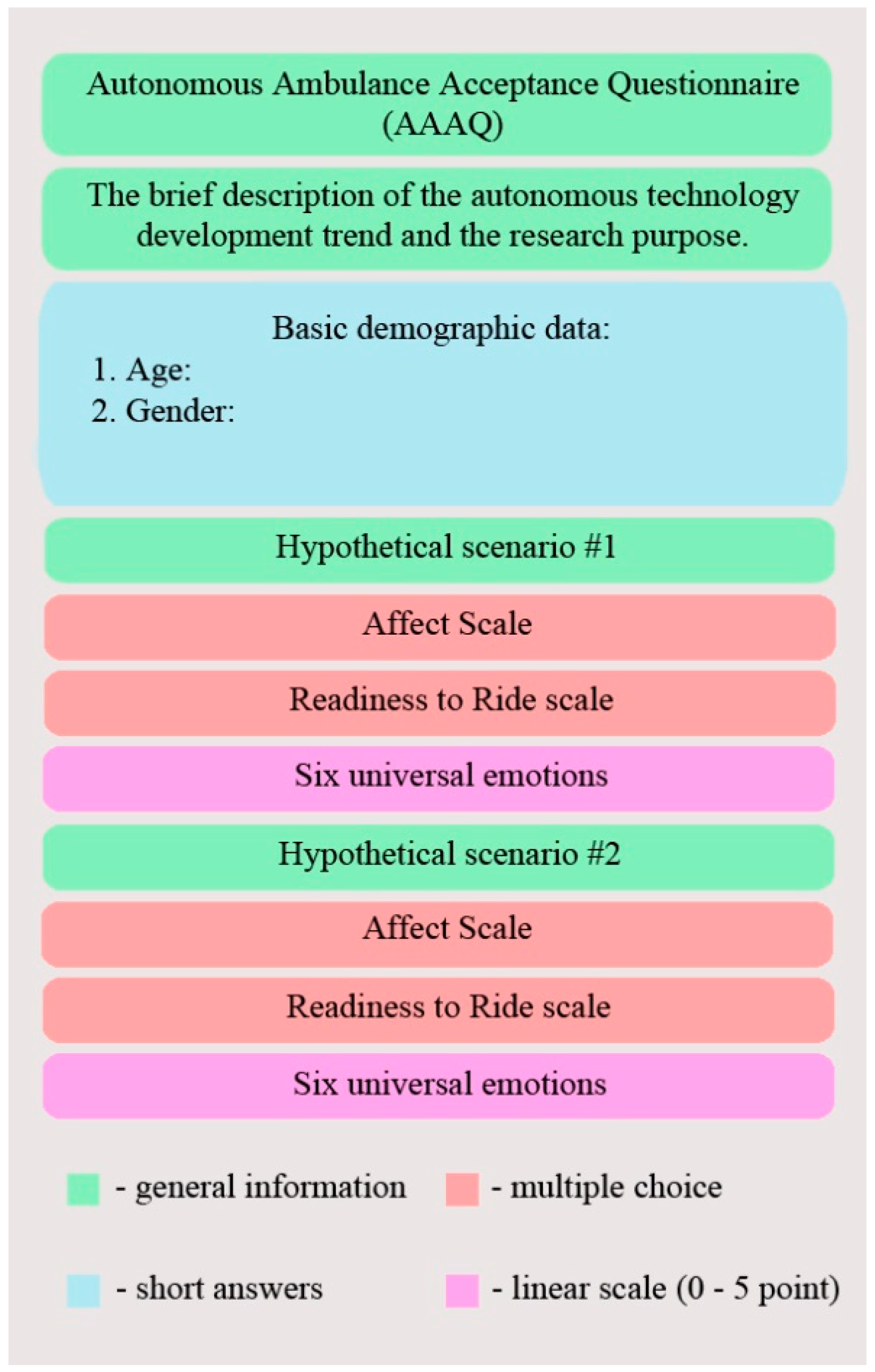

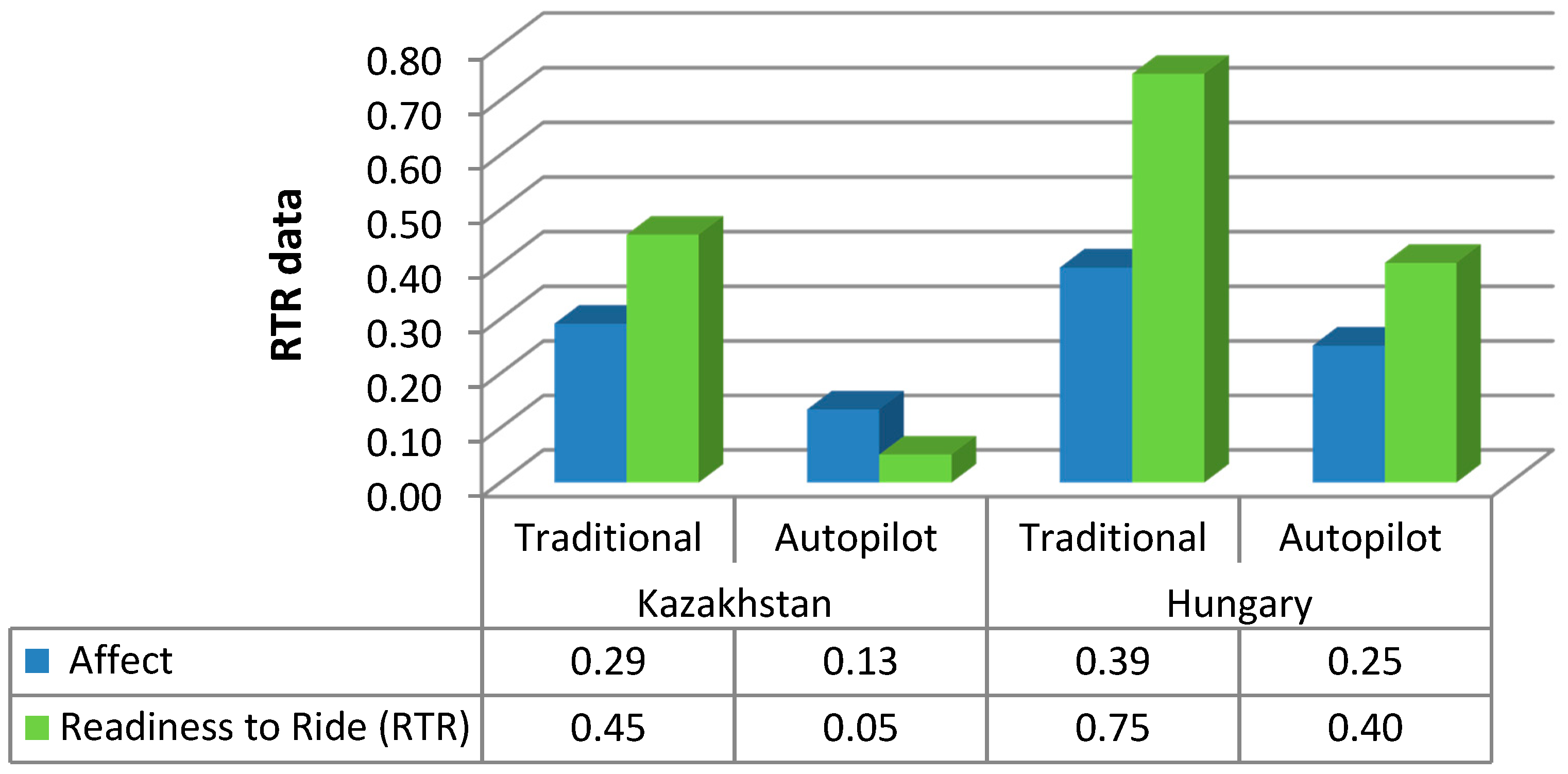

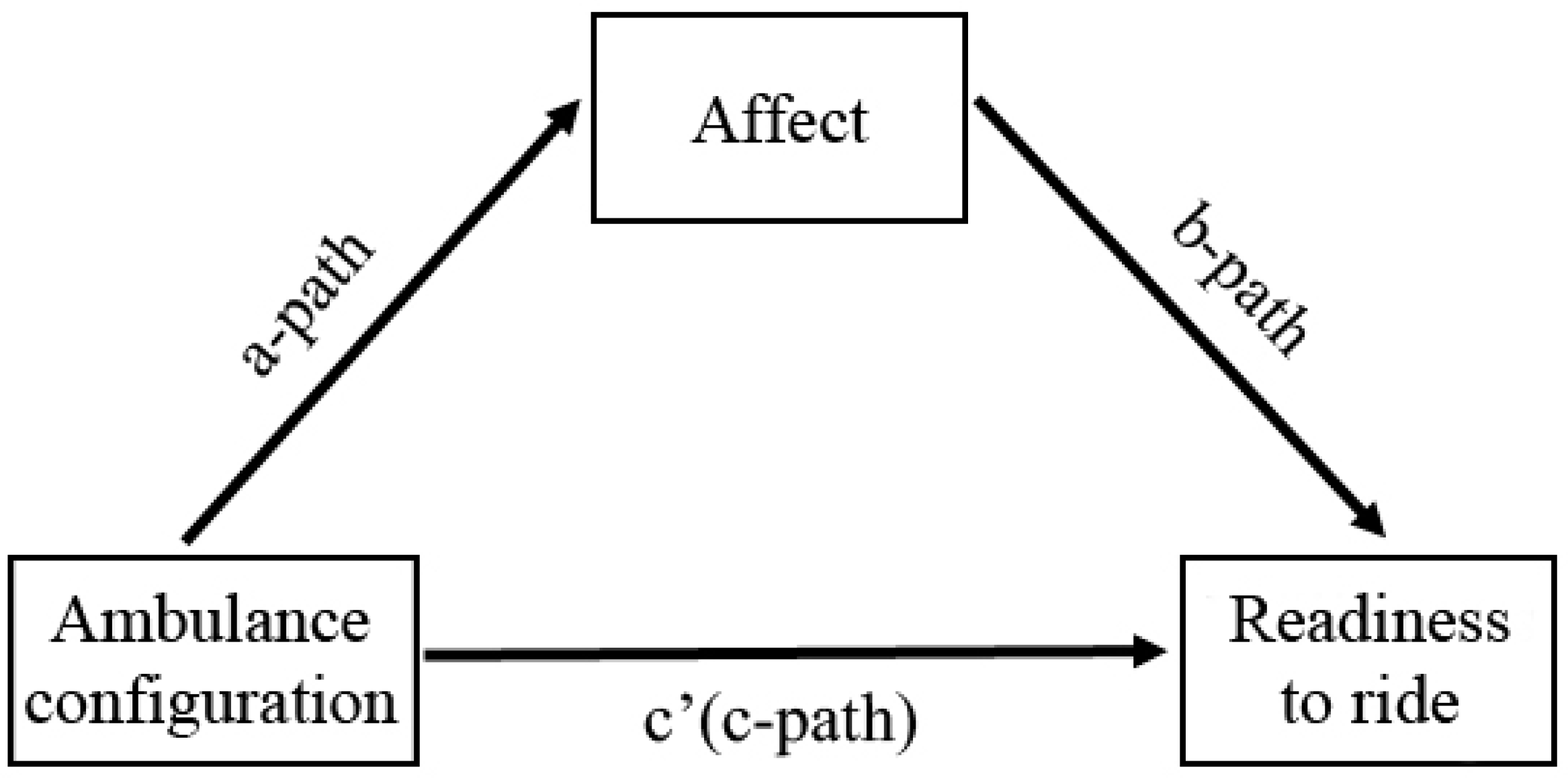
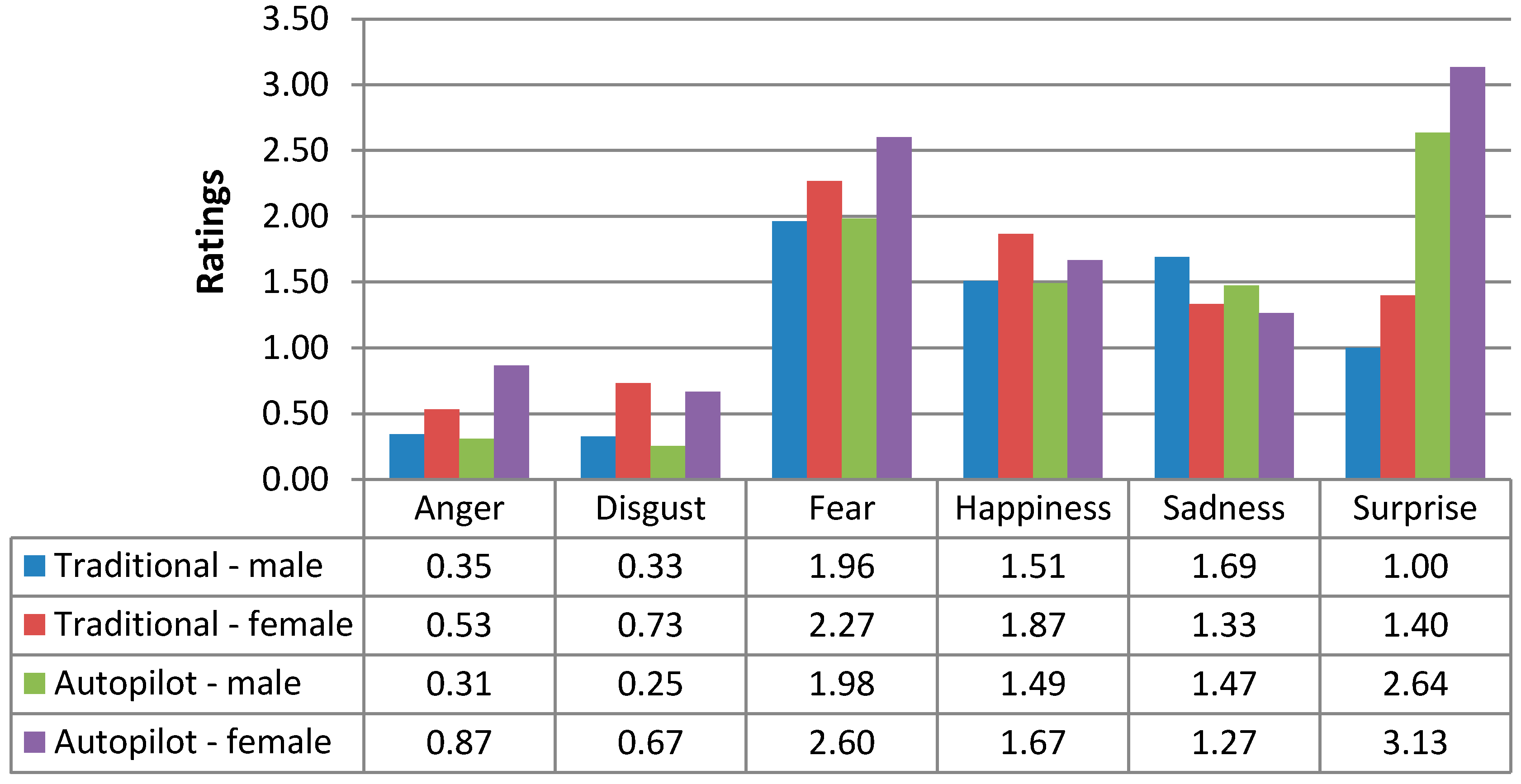
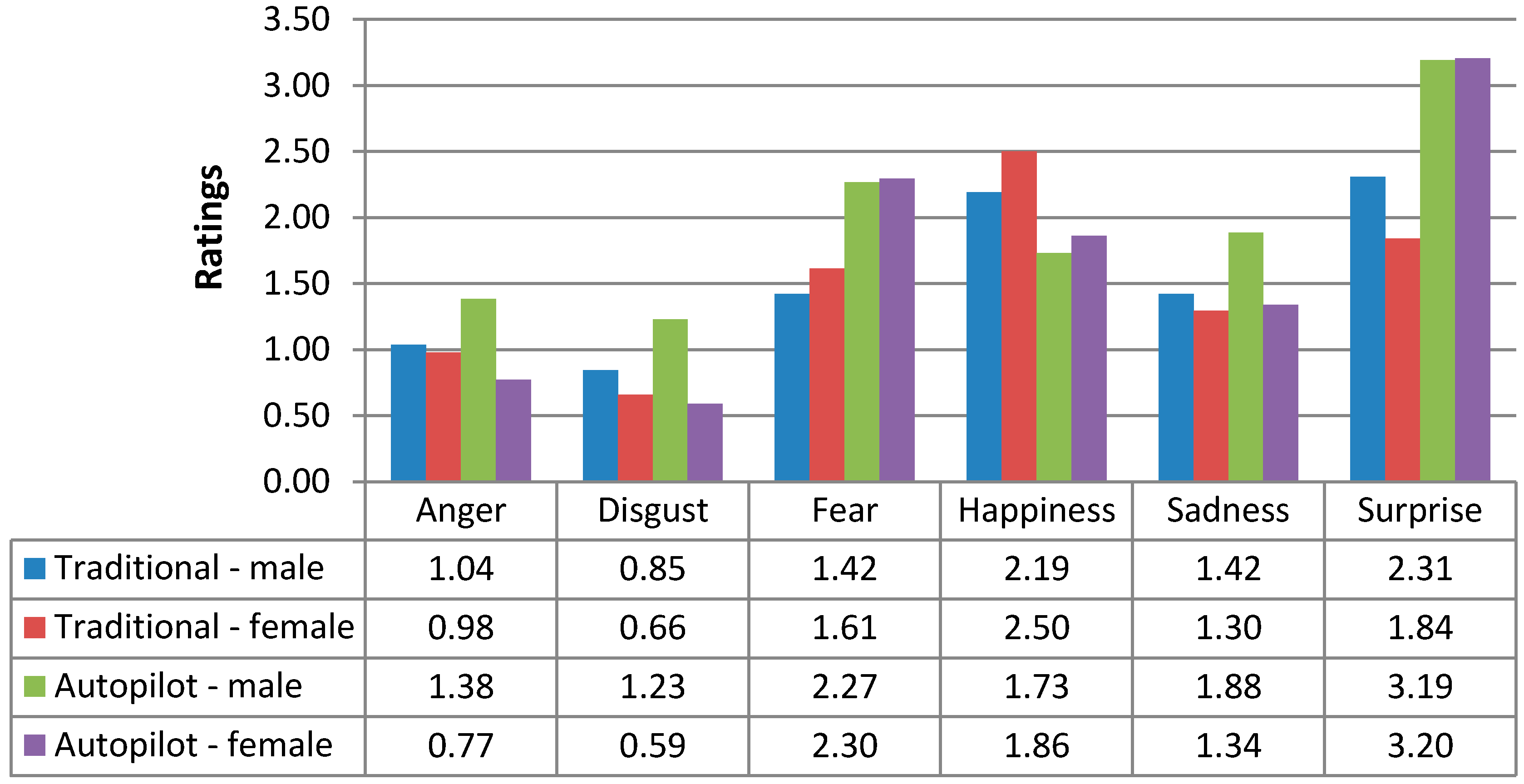
| Variables | Hungary | Kazakhstan |
|---|---|---|
| Number of respondents | 70 | 70 |
| Age | ||
| M | 22.54 | 28.20 |
| SD | 2.95 | 7.54 |
| Mode | Hungary | Kazakhstan | ||
|---|---|---|---|---|
| RTR scale | ‘Affect’ scale | RTR scale | ‘Affect’ scale | |
| Traditional | 0.75 | 0.82 | 0.89 | 0.87 |
| Autopilot | 0.84 | 0.80 | 0.94 | 0.94 |
© 2019 by the authors. Licensee MDPI, Basel, Switzerland. This article is an open access article distributed under the terms and conditions of the Creative Commons Attribution (CC BY) license (http://creativecommons.org/licenses/by/4.0/).
Share and Cite
Zarkeshev, A.; Csiszár, C. Are People Ready to Entrust Their Safety to an Autonomous Ambulance as an Alternative and More Sustainable Transportation Mode? Sustainability 2019, 11, 5595. https://doi.org/10.3390/su11205595
Zarkeshev A, Csiszár C. Are People Ready to Entrust Their Safety to an Autonomous Ambulance as an Alternative and More Sustainable Transportation Mode? Sustainability. 2019; 11(20):5595. https://doi.org/10.3390/su11205595
Chicago/Turabian StyleZarkeshev, Azamat, and Csaba Csiszár. 2019. "Are People Ready to Entrust Their Safety to an Autonomous Ambulance as an Alternative and More Sustainable Transportation Mode?" Sustainability 11, no. 20: 5595. https://doi.org/10.3390/su11205595
APA StyleZarkeshev, A., & Csiszár, C. (2019). Are People Ready to Entrust Their Safety to an Autonomous Ambulance as an Alternative and More Sustainable Transportation Mode? Sustainability, 11(20), 5595. https://doi.org/10.3390/su11205595





